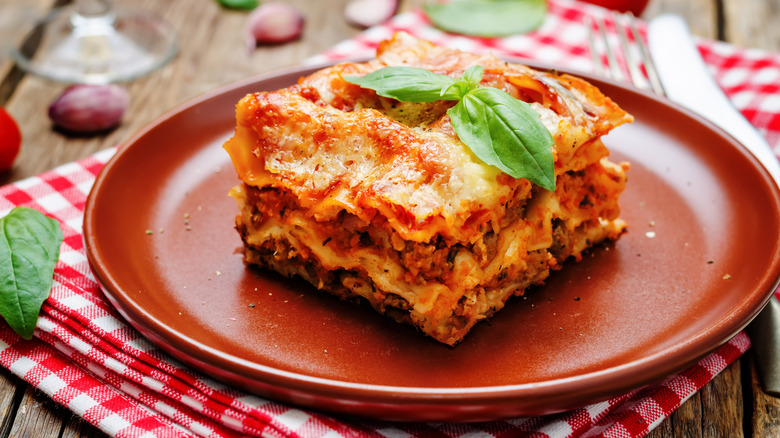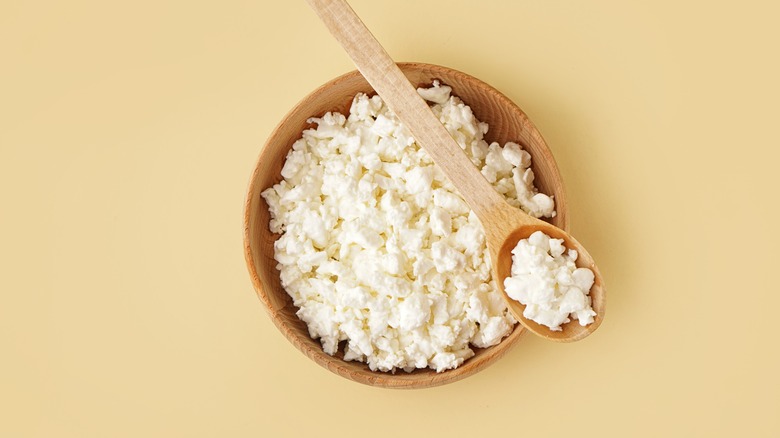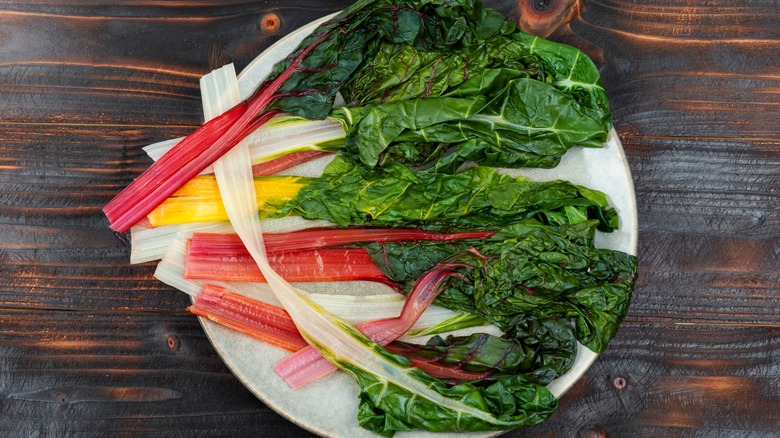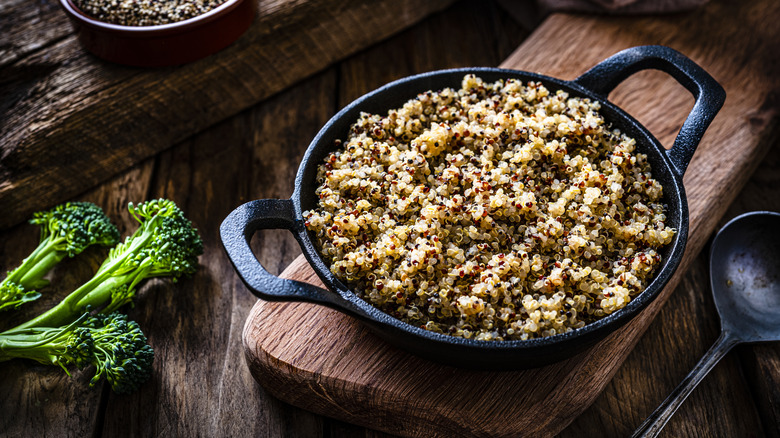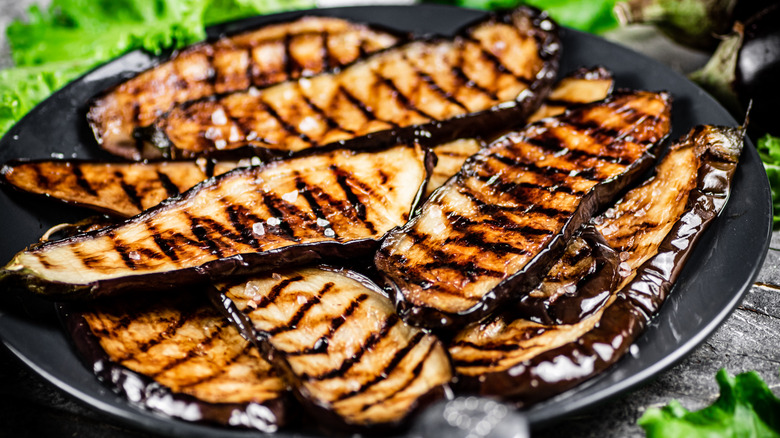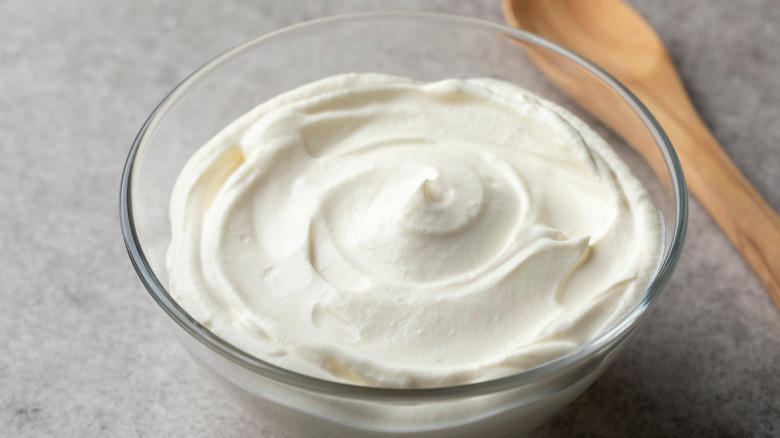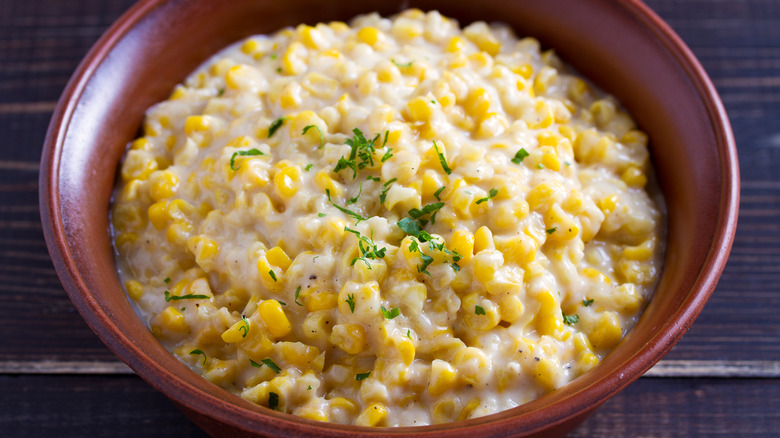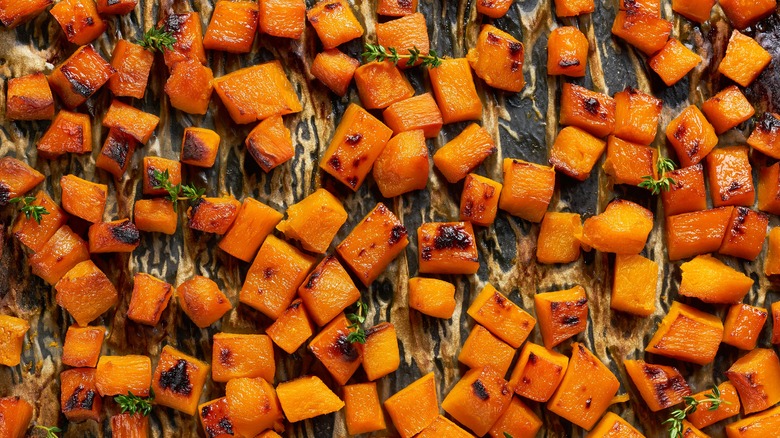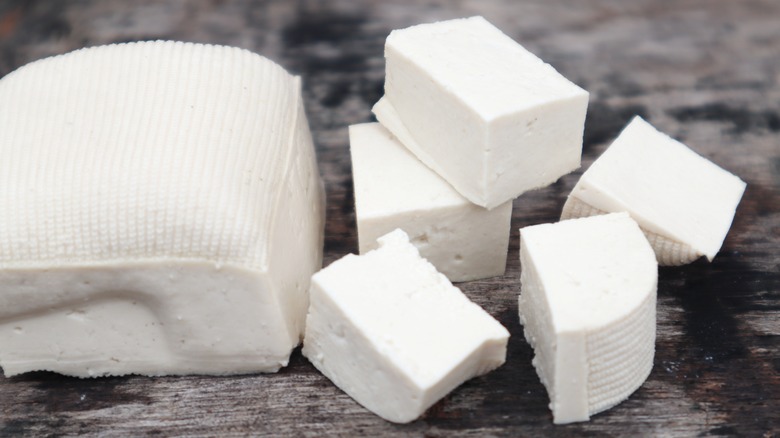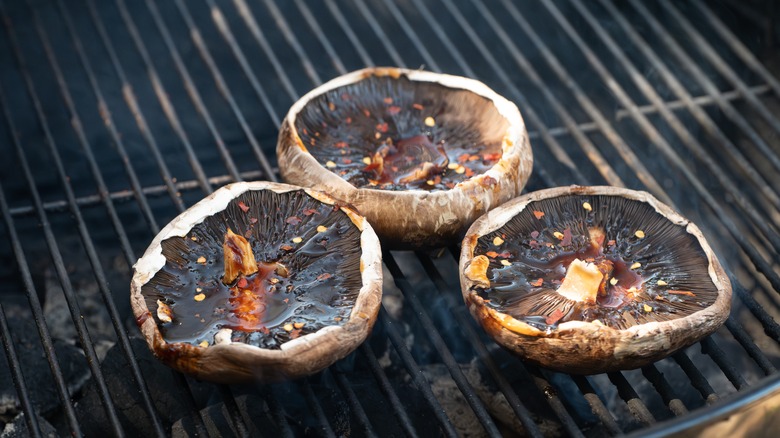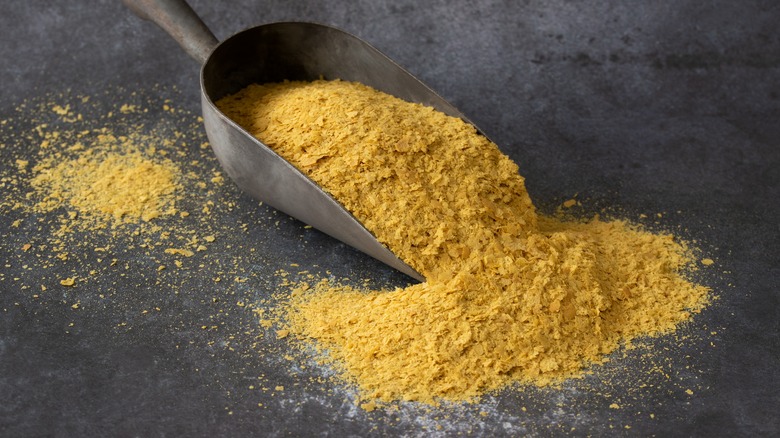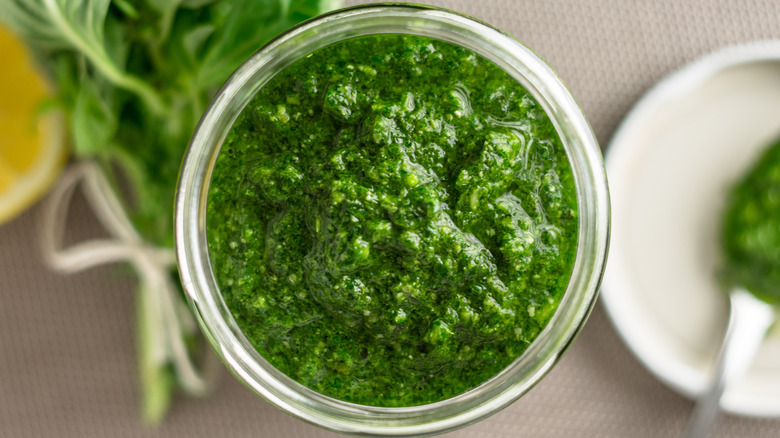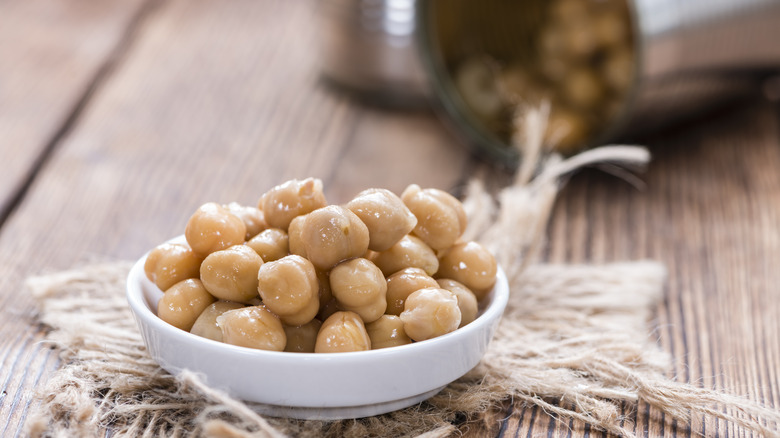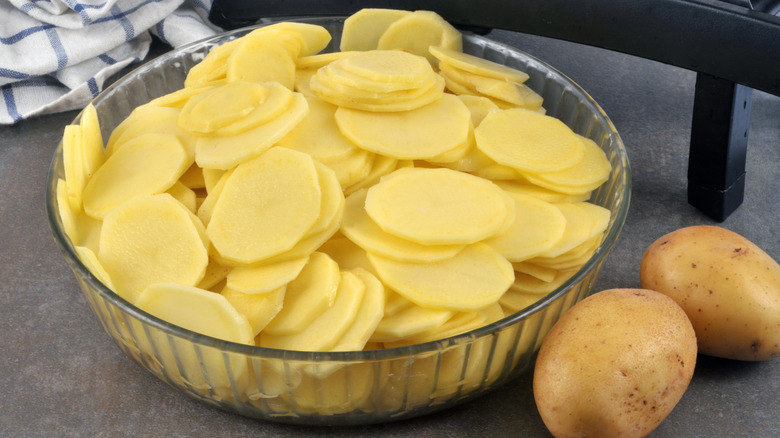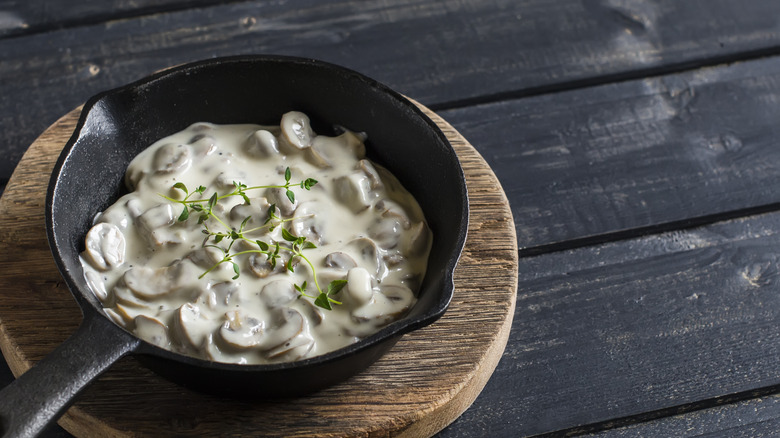Make Lasagna Even Better With These Chef-Approved Ingredient Swaps
A classic lasagna recipe is a hearty, crowd-pleasing, one-dish meal. It can be made quickly, with the help of some store-bought ingredients, or turned into a day-long labor of love, using only homemade components. If you enjoy making lasagna from scratch and taking the time to prepare each layer to perfection, there are some ways you can make this dish even better, with chef-approved ingredient swaps.
In my nearly two decades as a professional chef, I have made countless lasagnas. It's one of the dishes I most frequently serve for large groups because it's a universal favorite. That said, I've encountered a number of different dietary restrictions, unique preferences, and difficulties in obtaining certain ingredients that have forced me to flex my creative muscles and come up with lasagna component alternatives. These distinct challenges have often proven to be opportunities in disguise for discovering ways in which I can make a tastier and more interesting lasagna. I am here to share these revelations with you to help transform your lasagna into something transcendent.
1. Swap the ricotta cheese with cottage cheese
While not every recipe for lasagna adds a layer of ricotta toward the bottom of the dish, mine does. I love the creaminess it adds in juxtaposition to the acidic tomato sauce and the umami-rich ground meat. Ricotta, which literally translates to "recooked" in Italian, is a type of dairy product that is made by reheating the whey which is left behind during the cheesemaking process. This results in a milky, soft, luscious, cheese-like product that has a delicately sweet flavor and a texture that is punctuated by small curds.
Sometimes, it can be difficult to obtain a quality, full-fat variety of ricotta. For this reason, I often substitute more readily available cottage cheese. Cottage cheese is produced by incorporating an acid into whole milk, which results in the uncoupling of the curds from the whey. These curds tend to be slightly larger, moister, and tangier than ricotta. Cottage cheese is also lower in fat and calories, but higher in protein content. Despite these differences, cottage cheese can yield a tasty lasagna with a boost of nutrition. Just be sure to strain it before adding the curds to the lasagna recipe so that it does not water down the final dish.
2. Substitute spinach with kale or Swiss chard
Another ingredient that is often added to lasagna — perhaps to make the dish an homage to the Italian flag — is spinach. I generally use frozen, chopped spinach (that I have thawed and drained of excess liquid), before layering it below the ricotta to prevent it from leaching excess moisture onto the dairy. That said, for a change of pace, there are many other leafy greens that can successfully be incorporated into lasagna for flavor, texture, and nutritional value, such as kale or Swiss chard.
When working with kale or Swiss chard, I will often blanch the fresh leaves and chop them up before adding them to the lasagna. Alternatively, if you want to extract more flavor from these greens, you can sauté chopped leaves in minced garlic and olive oil, with a hint of salt, pepper, and a splash of lemon juice, to keep them a verdant hue. Whichever greens you choose, do not use them in raw format. They will release too much liquid into the lasagna, making it soggy.
3. Replace the meat with quinoa
Ground meat — usually beef, sausage, pork, lamb, venison, or any combination thereof — is a staple of many lasagna recipes. However, if you are seeking to turn lasagna into a vegetarian delight, or are trying to adapt a recipe for a meatless Monday, one of my favorite substitutions for meat is quinoa. Quinoa is a pseudo-grain composed of seeds obtained from a plant in the amaranth family. It's nutritionally unique in that, like meat, it's a complete protein, containing all nine essential amino acids that the human body requires to function.
To use this ingredient in lasagna, it's important to learn how to cook quinoa properly. Poorly cooked quinoa can be slightly bitter and toothsome. But when rinsed and gently simmered, quinoa develops a nutty flavor, and a fluffy, absorbent texture that acts like a chameleon, soaking up everything around it. When making quinoa for lasagna, I cook it in vegetable stock flavored with Italian seasoning, garlic powder, onion powder, and a hint of freshly grated nutmeg. Once finished, I stir in a little bit of tomato sauce before layering it over the lasagna noodles.
4. Exchange the lasagna noodles for grilled eggplant or zucchini
When it comes to lasagna noodles, the debate that often takes center stage is the topic of using no-boil versus traditional pasta. While this is a valuable discussion to have, you can eliminate the conundrum entirely by swapping the noodles out with eggplant or zucchini. These options are not only delicious, they are gluten-free, making your lasagna suitable for those with celiac disease or gluten intolerances.
Both eggplant and zucchini tend to have a spongy texture that leaches moisture as it cooks and absorbs grease. This can make the vegetables squishy if not prepared correctly. The key to using them as noodles in lasagna is to cut these vegetables lengthwise into ¼-inch thick slices, and sprinkle them with salt. By allowing the salted vegetable slices to sit for about 30 minutes, much of the excess moisture will be drawn out of them, allowing you to grill them up to a firmer, less absorbent texture. And, contrary to what you may think, you should never peel eggplant or zucchini before grilling it. Doing so will result in the slices disintegrating. Once grilled, sprinkle the eggplant or zucchini with garlic powder, freshly cracked pepper, and Italian seasoning before assembling your lasagna.
5. Trade the bechamel sauce for crème fraiche
Béchamel is one of the five classic "mother sauces" of French cuisine. At its core, it's similar to a basic gravy. It contains a thick roux of butter and flour that is whisked together with milk until smooth. The sauce is often seasoned with salt, white pepper, and a pinch of freshly grated nutmeg. When layered atop a lasagna, it helps to hold the ingredients together and develops a golden brown crust that juxtaposes the acidic notes of the tomato sauce and the savoriness of the meat.
That said, making a perfect béchamel takes some know-how and finesse to execute properly. If you are searching for an alternative that doesn't require prep work and performs similar functions to béchamel, you can substitute this sauce with crème fraiche. True crème fraiche is made by introducing live bacterial cultures into cream, souring it. It's thinner than sour cream and has a lighter flavor. When using it for lasagna, I recommend whisking it together with some freshly grated parmesan cheese, salt, pepper, and freshly grated nutmeg before spreading it atop your layered dish.
6. Swap the tomato sauce with creamed corn
Another unique yet effective alternative to tomato sauce in lasagna is creamed corn. Corn may seem like it isn't especially Italian. However, polenta (or ground cornmeal) is a popular delicacy in Italy. Indeed, both tomatoes and corn arrived in Italy from the New World in the 15th and 16th centuries, during a period known as the Columbian Exchange. They have since become bedrocks of the Italian culinary tradition.
Creamed corn has the benefit of added moisture — in the form of milk or heavy cream — to help give it a more saucy texture and a luxurious flavor that can easily complement the other components in a meaty lasagna. When using it in place of tomato sauce, I recommend first blending it in the food processor or blender to help break up any larger pieces of corn that may be present. Though canned creamed corn will work, it can be excessively salty. Plus, it's easy to whip up a batch of homemade creamed corn, and leftovers can easily be frozen for later use.
7. Replace the meat with roasted butternut squash
Speaking of vegetarian options for lasagna, one of the most popular variations I make uses butternut squash in place of the ground meat. Though not as protein-rich as quinoa, butternut squash has other valuable nutrients that make it a healthful option. And, it is visually stunning in contrast with the other colorful layers of lasagna.
Butternut squash has a distinct, nutty, sweet flavor. When properly cooked, it also has a texture that is somewhat more supple than other hard, winter squash varieties. The best way to prepare it to maximize its inherent desirable qualities is to roast it rather than boil it. The peeled, seeded, and cubed squash gets drizzled with olive oil and topped with salt, pepper, smoked paprika, and Italian seasoning before it is baked in the oven until golden-brown and tender. You can either leave the chunks of roasted squash as-is, or purée them in a food processor before adding them to your lasagna recipe.
8. Substitute the ricotta with silken tofu
As previously noted, ricotta is a fabulous, creamy addition to lasagna, providing much-needed balance to the acidic tomato sauce and robust meat. That said, if you happen to be dairy intolerant, or don't care for it, you may be searching for an alternative to ricotta that can confer a similar luscious texture and a mild flavor that is capable of complementing the other components of the lasagna. Enter silken tofu to the rescue.
Unlike regular tofu, the silken variety is not formed by subjecting the soy curds to pressure to separate them from the whey. It is allowed to remain moist, giving it a mouthfeel that is frequently described as pudding-like. When using silken tofu in lasagna, it is recommended that you strain any excess moisture from it before incorporating it into your recipe, otherwise, your lasagna may fall apart when you try to serve it. To drain silken tofu, simply place it on a plate after removing it from the packaging, or pat it dry with a paper towel before cutting it into cubes and stirring it together with seasonings to taste.
9. Trade the lasagna noodles with grilled portobello mushrooms
Sauce isn't the only place where mushrooms can shine in a lasagna recipe. They can easily be swapped for the lasagna noodles for a gluten-free, low-carb iteration that is every bit as satiating and delicious. The key is to use large, meaty portobello mushrooms. These super-sized fungi pack a flavorful punch, particularly when they are grilled or roasted. These cooking methods help to firm up their texture, eliminating a lot of the moisture that can make mushrooms spongy. They also confer a nutty, rich flavor, thanks to the transformation that occurs as a result of the Maillard reaction.
When using portobello mushrooms, I recommend scooping out the dense, dark gills on the underside of the cap using a teaspoon or a melon baller. Doing so will help create a meatier texture and will eliminate any residual grittiness that can give the mushroom an unpalatable texture. I also peel my mushrooms rather than wash them, a process that prevents them from absorbing water, giving them an unpleasantly spongy mouthfeel. Lastly, don't forget to flavor the mushrooms well with olive oil, salt, pepper, garlic powder, and Italian seasoning before cooking them.
10. Exchange the cheese for nutritional yeast
I almost always top my lasagna with a combination of freshly grated parmesan and mozzarella cheese. This extra layer of cheese helps the lasagna to develop a golden brown, umami-rich crust that gives it a marvelous flavor and a velvety texture. In the absence of cheese, you may wonder what you could use to create the illusion of this nutty, robust quality atop your freshly baked lasagna. The key is an ingredient that has become quite popular in vegetarian and vegan circles: nutritional yeast.
Nutritional yeast, often known as "nooch," is produced by dehydrating a yeast formed from the Saccharomyces Cerevisiae fungus. Unlike regular baking yeast, this product is not used for leavening. It is crumbled into flakes and sold in both fortified and non-fortified iterations. The superpower of this yeast is its high concentration of glutamic acid, one of the key components of meat and dairy products that is responsible for that umami flavor. While nutritional yeast won't melt, it does toast when baked in the oven, developing its characteristic nutty flavor and enhancing its bronzed hue. To use nutritional yeast, simply sprinkle it atop your lasagna before popping it in the oven.
11. Swap the tomato sauce with pesto
While tomato sauce is a traditional element of a classic lasagna recipe, the amount of acidity in it can be problematic for some individuals. If this is the case, you can still create a delectable lasagna by substituting the tomato sauce with pesto. This herbaceous blend of fresh basil, pine nuts, garlic, olive oil, and parmesan cheese is a common topping for pasta dishes of all kinds, making its use in lasagna a natural fit.
Though there are plenty of store-bought variations of this ingredient that you can keep in your pantry, making your own pesto is always preferable. Not only will you obtain a brighter, fresher flavor, but you can also swap out the herbs with whatever you happen to have on hand. I enjoy using a combination of basil, mint, and parsley for a more complex flavor. You can also use different nuts, such as toasted almonds, pistachios, or macadamias, which create a super creamy iteration of pesto. If you happen to have leftovers, transfer the pesto into an ice cube tray and freeze it. This way, you will have it on hand whenever you plan to make lasagna.
12. Substitute the meat with chickpeas or other beans
Whether you are trying to consume less meat for health reasons, environmental concerns, or just trying to save a buck or two, chickpeas and other beans are a great, protein-rich alternative that can have marvelous flavor and a satiating texture. The keys to achieve perfect chickpeas are a little bit of preparation and know-how.
Though you can use dried beans, they take a lot of time to prepare from scratch. If you are seeking to save time, canned beans are perfectly fine to use for lasagna, as long as they are properly drained and rinsed. Rather than dumping the plain beans straight into your lasagna, I recommend sautéing them first, along with some Italian seasoning, garlic, and a hint of tomato sauce. This will help to infuse them with flavor before they are layered into the final dish. For added texture, try topping your lasagna with a handful of seasoned and roasted chickpeas for a surprisingly crunchy and umami-filled bite.
13. Replace the lasagna noodles with sliced potatoes
Pasta isn't the only starch that can make for a dynamite lasagna. Potatoes are equally effective at producing a luxurious and mouth-watering lasagna if you use the right kind. Potatoes can be categorized as either starchy or waxy varieties. Starchy potatoes are higher in starch and contain less moisture and sugar, making them ideal for baking, mashing, and french fries, where the goal is to obtain a fluffy, creamy end product. Typical examples of a starchy potato include russets. Waxy potatoes, by contrast, are ones that are lower in starch and have abundant sugar and moisture. These potatoes tend to perform better in casseroles, salads, or stews, where the goal is for the potato to remain intact without disintegrating into the dish. Among the better-known waxy potato varieties are fingerlings and new potatoes.
For the purposes of lasagna, it's best to utilize a waxy potato that can withstand the weight of the other ingredients in the dish without dissolving. Once the potatoes are peeled, they should be sliced thinly using either a sharp chef's knife or a mandoline. Submerge the potato slices in cold water until you are ready to assemble the lasagna, so that they do not begin to turn brown.
14. Trade the tomato sauce for mushroom gravy
Another delicious and savory alternative to tomato sauce in lasagna is a velvety mushroom gravy. Mushrooms are one of the ultimate umami-rich foods. They are loaded with glutamates, which make our taste buds perk up with delight. Anyone who has ever made a green bean casserole using canned mushroom soup will understand the utility of mushroom gravy in a lasagna. Like tomato sauce, the gravy adds moisture and acts like a binder, drawing the various layers of the lasagna together harmoniously.
Though you may be tempted to use canned soup for this purpose, I highly suggest making your own mushroom gravy. For best results, consider using a combination of different varieties of mushrooms, like creminis, chanterelles, porcinis, and buttons. If you cannot find fresh mushrooms, dehydrated mushrooms are widely available and can easily be converted into a sauce by resuscitating them in hot water before sautéing them together with minced garlic, Italian seasoning, and heavy cream. If you are concerned about the gravy being chunky, chop the fungi up finely and turn them into something akin to a mushroom duxelles recipe.
